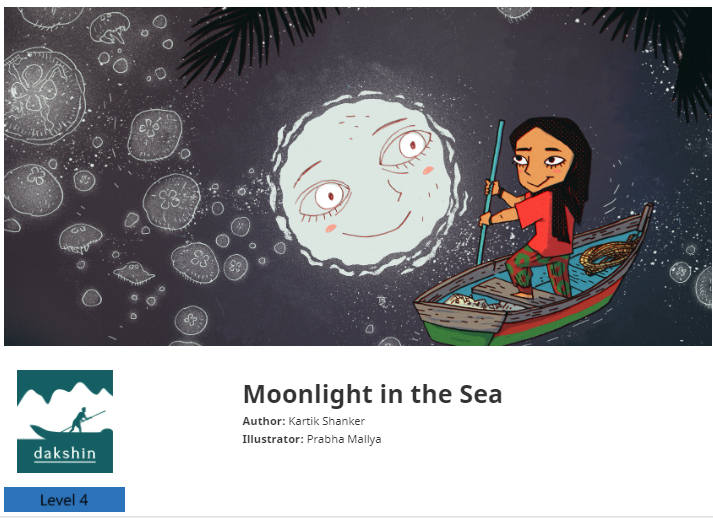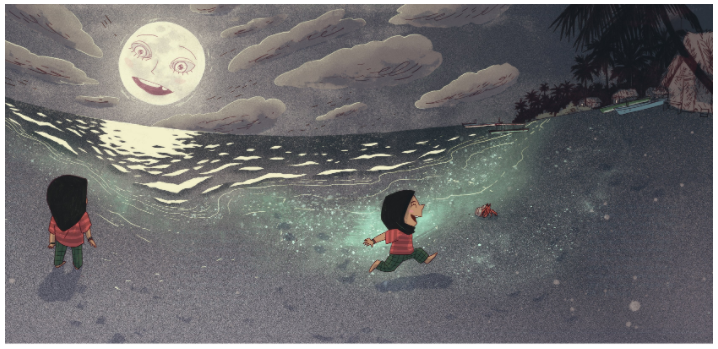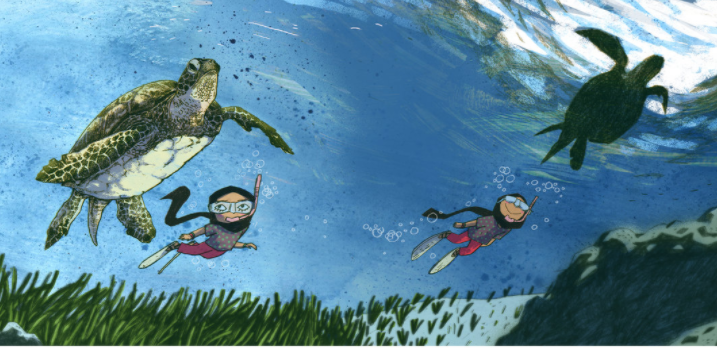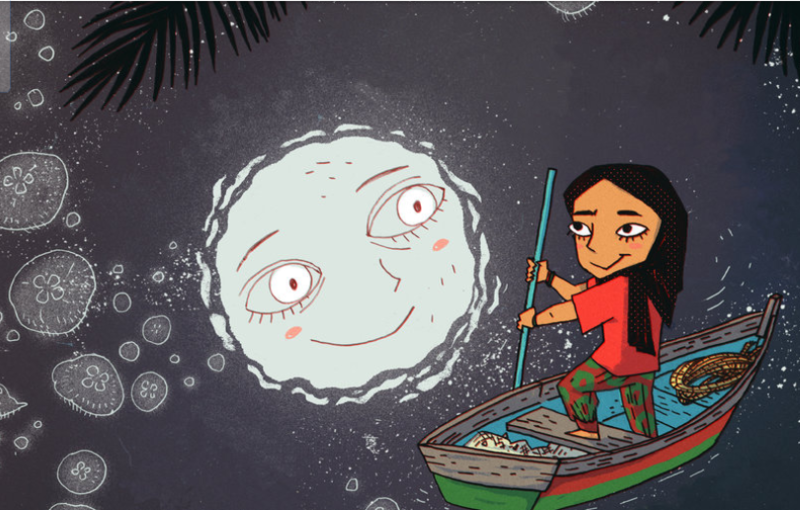The making of 'Moonlight in the Sea' | A guest post by Kartik Shanker, Dakshin Foundation
Posted by Pallavi Kamath on January 15, 2021New on StoryWeaver:
'Moonlight in the Sea' (written by Kartik Shanker, illustrated by Prabha Mallya, and published by the Dakshin Foundation) tells the story of Fatima who lives on an idyllic island in the Lakshadweep, watched over by Nihla, the moon. It introduces young readers to the underwater world of colourful corals, fascinating fish, mysterious manta rays, grizzled old turtles and dancing dolphins.

Learn more about the people and places that inspired the making of 'Moonlight in the Sea', in this blogpost by Kartik Shanker, author, ecologist, and founder trustee of the Dakshin Foundation:
As an aspiring wildlife biologist, you learn pretty early on not to expect National Geographic scenes when you visit a forest. It may take months to see your first elephant, years to see a tiger. It took me weeks of turtle walks to see my first olive ridley. But, put on a mask and a snorkel and stick your head under water at a good reef, and it looks pretty much like that last NGS show you watched.
I still remember the first time I went snorkeling in the Lakshadweep in 2001 – ‘the flurry of colour, the shock of shapes’. We were conducting sea turtle surveys there, and I spent every spare moment paddling around in the waters of the Kavaratti lagoon. A decade later, as part of Dakshin Foundation, we started a project on the tuna fishery in the islands. We monitored tuna using a participatory monitoring programme with the fishers, and one of our researchers, Mahima Jaini, conducted in-water surveys of baitfish. Around the same time, my student, Anne Theo had started her research on mixed species groups of reef fish.

At Agatti, the two of them would use Jaffer’s fishing boat to conduct their dives. Throughout their time there, his support for their field work and dive surveys was invaluable. Jaffer looked after them as he would his family. In the evening, he and his wife would visit with their daughter Nihla, then an adorable 3-year-old. His boat was named after her, Nihla Fatima. The gentle ethos of the Lakshadweep, the still waters of the lagoons, the richness of its marine life, the solitary charm of Suheli all cried out for a story to be told.
Nihla inspired that story – about a little girl in the Lakshadweep, and the possibility that such girls could one day become marine biologists like Anne and Mahima.

I visited them frequently – happy times were spent diving off Jaffer’s boat. One time, we dived off Bangaram, saw some sharks, and then ate the most delectable fish biryani cooked on the boat. Another time, the three of us made a trip to Suheli, an uninhabited island several hours by boat from Kavaratti. In 1979, my mentor, Satish Bhaskar, had spent 5 months there by himself during the monsoon to survey green turtles. Many of these memories found their way into the narrative.
And then Prabha Mallya made the story come alive with her amazing and evocative illustrations. In my story, Nihla, the moon was a quirky character; through Prabha’s illustrations, she became a co-star. My niece’s daughter Ariana, age 2, was heard to say ‘When I grow up, I wanna be Nihla moon!" I guess that says it all.

Click to read 'Moonlight in the Sea'
A big thank you, Kartik, Prabha and the Dakshin Foundation, for open licensing this wonderful book and making it available on StoryWeaver!
Illustrations in this post are by Prabha Mallya, from 'Moonlight in the Sea', written by Kartik Shanker, published by the Dakshin Foundation.
Kartik Shanker is a founder trustee of Dakshin Foundation. An ecologist by training, Kartik has interests in both mountain and marine systems. His work with marine turtles in the last 20 years has led to broader interests in coastal and marine conservation. Currently, he serves as an Associate Professor at the Centre for Ecological Sciences (CES), Indian Institute of Science (IISc.), Bangalore. In addition to academic research, he is also interested in strategies to improve environmental education and the public understanding of science. This interest encouraged Kartik to establish Current Conservation, a magazine that bridges conservation and art by bringing together research professionals, writers and artists from different parts of the world. He is the author of the book From Soup to Superstar, a historical account of sea turtle conservation in India. In his spare time, Kartik also seeks to distract young minds through children’s stories which include Lori’s Magical Mystery, Turtle Story, The Adventures of Philautus Frog, and Moonlight in the Sea.
Dakshin Foundation is a non-profit, non-governmental organisation. Their mission is to inform and advocate conservation and natural resource management, while promoting and supporting sustainable livelihoods, social development and environmental justice. They adopt interdisciplinary approaches in our research and conservation interventions, drawing from the fields of ecology, conservation biology, sociology, economics, and law. Their work aims at building community capacity for conservation and enhancing community engagement in environmental decision-making. Their goal is to promote ecologically and socially appropriate approaches to conservation and management in coastal, marine and mountain ecosystems in India.
comments (3)#FreedomtoRead 2019: Educator Ana Jovic on creating a hyperlocal Serbian library of 50 stories and living life with her family and other animals
Posted by Amna Singh on January 30, 2019A Serbian language teacher by profession, Ana Jovic loves to translate books. One of our language champions, Ana has played an important role in our #FreedomtoRead 2019 campaign and has just reached her goal of translating 50 stories into Serbian. In an email interview, she tells us how she hopes to build a repository of stories, by being a part of this campaign, for children from the Serbian diaspora and how much she enjoys the process of translation.
Tell us something about yourself and you connection with Serbian?
I am an English and Serbian teacher. Serbian is my native language. I studied the English language and literature, and teaching Serbian as a foreign language, so I hold two Master’s degrees. I’ve been teaching for 18 years now both online and in brick-and-mortar schools. Teaching is both my passion and profession. I love teaching and I hope to never stop doing it. I live in the countryside with one husband, two sons, four dogs and ten cats. In my free time, I enjoy a good book, a cup of black coffee, and furry company in the form of my cute cats in my lovely backyard.

What are the benefits of creating a hyperlocal library in your mother tongue?
As a Serbian teacher, I realised there are very few online books in Serbian for children. Besides, these resources don’t cater to different levels, ages or interests. Creating a hyperlocal library at Storyweaver will tremendously help children of Serbian diaspora to preserve Serbian as their heritage language. It would also help them develop their language skills and enjoy fiction in their mother tongue. This would enrich their personal experiences and allow for wider use in their heritage language schools. Such a library would also provide material for family reading time when parents and children share the language while reading and discussing stories.
You have now translated 50 stories to Serbian. How was the experience?
I loved it. I easily lose myself in translation, so the time stops for me then. I enjoyed each and every book both as a reader and translator.
Of the 50 stories that you translated, which story would be your favourite and why?
This is hard to answer. All of them are special. But if I had to choose one, let it be Counting Cats. It’s about a boy who rescues cats and brings them all home. He ends up with a bunch of cats. I can relate to this story since I’m like the boy – I have ten cats. I couldn’t resist their cuteness and helplessness so I rescued them all. Now, I have ten cats and still counting. Just like the boy from the story.

Did you face any challenges while translating a particular text and how did you overcome the same?
I have to admit that translation is an enjoyable and easy process for me. However, I find it hard to translate rhymes. You have to find rhyming words in Serbian that can keep the meaning of the original rhyme. That’s the hardest part which takes most time and energy. The way to deal with it is to think hard, play with words and try as many combinations as possible to find the one that works. However, once I find a solution that sounds good and means the same as the original, I feel immense satisfaction.
Do you plan to share the stories you have translated?
I would like to present the platform and the stories to a Serbian audience. I do hope that the stories will soon reach all children of the Serbian diaspora who would like to read but can’t get hold of books in Serbian easily. I hope that this Serbian library will become the families’ favorite resource of Serbian storybooks.

You can read the Serbian stories translated by Ana Jovic here.
Be the first to comment.
Step into the StoryWeaver Story Corner and win prizes!
Posted by Remya Padmadas on September 30, 2017CONTEST DEADLINE EXTENDED TO OCTOBER 30TH, 2017
September 30th is celebrated around the world as International Translation Day. At Pratham Books StoryWeaver we take translations very seriously! After all, it’s thanks to them that we’re able to take books to so many children across India, in a language they understand.
While children love to read stories and be read to, they also love to hear and see stories enacted! Which is why this year, for International Translation Day, we thought it was time to find and share more engaging, multilingual video resources with our community. That’s where you come in!

The StoryWeaver StoryCorner contest
It’s simple, we’re sharing a list of some of our original language and translated books which we think lend themselves beautifully to reading aloud. We want you to send us a video of yourself enacting the story or reading it out loud in the most engaging way possible. The best entry will win a book hamper from Pratham Books and a signed illustration by celebrated children’s book illustrator Rajiv Eipe.
Contest Guidelines and Rules
- Contest is open from September 30 - October 30th, 2017
-
All entries must be uploaded to YouTube and the YouTube link shared with us along with a small note about yourself and the title of the story you chose via email to [email protected]
-
Entries must not be longer than 7 mins
-
Entries of the stories shared on this page alone will be considered for the competition.
-
Contestants must be 18 years and above to participate.
-
Participants can submit more than one entry.
-
Prizes can only be couriered to an address in India.
Tips and Tricks
- Make sure you practice before filming. In front of the mirror or use your cats and kids as an audience.
-
Set your camera in landscape mode (horizontal)
-
Find a quiet space to film. Avoid filming near windows or in common shared spaces.
-
To reduce ambient noise, switch off fans, air conditioners and mixer grinders!
-
Remember your story could be used by our outreach partners in the classrooms they teach in. So while you might be telling the story to your camera, imagine there’s a bunch of kids listening! Really TELL the story.
Here are the books you can choose from
Pehelwanji learns a slippery lesson Available in Hindi, Kannada, Marathi, Urdu and Telugu.
Not now, Not now in Hindi, Marathi, Kannada, Tamil, Bengali, Odia, Telugu
Ting, Tong Telugu, Marathi, Eng-Kannada, Eng-Tamil, Eng-Hindi
I Want That One Hindi, Kannada, Marathi, Urdu
Satya, Watch Out! Hindi, Marathi, Kannada, Tamil
Doong, Doong, Dum, Dum Hindi, Marathi, English-Hindi, English-Marathi, Juanga-Odia
Gulli’s Box of Things Hindi, Marathi, Kannada, Tamil, Bengali, Odia, Telugu, Gujarati
Mouse in the House Hindi, Tamil, Telugu, Kannada
Angry Akku Hindi, Marathi, Kannada, Tamil
Aunty Jui’s Baby Marathi, Hindi, Kannada, Telugu, Urdu
Smart Sona Hindi, Kannada, Marathi, Tamil
Ghum Ghum Gharial’s Amazing Adventure Hindi, Marathi, Kannada, Tamil
Tok Tok Hindi, Kannada, Marathi, Tamil, Telugu
Asila Basila Uthila Jaucha Kui-Odia, Hindi, Marathi
What Happened to the Old Shawl? Hindi, Tamil, Telugu, Kannada, Marathi
Translations of these stories in other languages do exist, however these are by community members. Do try and choose a story from the above list that has a ‘Recommended’ tag. If you can’t find the story you’d like to narrate in a language you’re fluent in, then do go ahead and translate the story on StoryWeaver and then use it!
You can download and print the story (or stories) you will be reading aloud, or read them from a mobile phone or tablet.
If you have any questions do write to us at [email protected]
Be the first to comment.